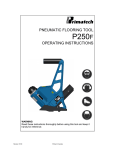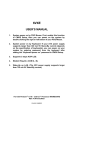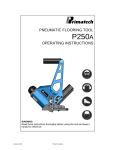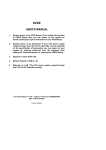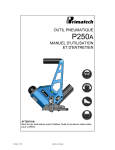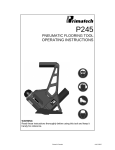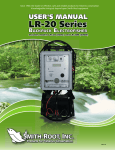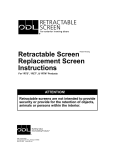Download PNEUMATIC FLOORING STAPLER OPERATING INSTRUCTIONS
Transcript
PNEUMATIC FLOORING STAPLER P260 OPERATING INSTRUCTIONS WARNING Read these instructions thoroughly before using this tool and keep it handy for reference. Revision 12/10 Printed in Canada PNEUMATIC STAPLER P260 is a heavy duty precision tool specially developed for the installation of hardwood flooring. Weighting only 11 pounds (5 kg), this ergonomically designed tool makes the installation of hardwood floor very easy, allowing the operator to set and nail the boards in the standing position. It uses standard ½" crown flooring staples available in lengths of 1½" (38mm), 1¾" (44mm) or 2" (50mm). For best result, only Primatech staples should be used. For maximum performance, the manufacturer guidelines should be followed. Read carefully these instructions before operating this tool. It is important to understand warnings/cautions and the safety measures to ensure safe use of this tool. 12. Always wear OSHA-required Z-87 safety glasses with side shields. 13. Always wear proper ear and feet protection while the air supply hose is connected. 14. Always remove cleats from the feeder channel before servicing the tool. DO NOT REMOVE OR ALTER SAFETY. NEVER DEPRESS THE SAFETY CONTACT WITH YOUR HANDS WHEN TOOL IS CONNECTED TO AIR SUPPLY. EXTREME CAUTION IS ADVISED WHEN USING THIS TOOL. CONNECTION & AIR SUPPLY SYSTEM Additional information is available directly from the manufacturer: 1135 Jeremy-Fortin, Québec, QC Canada, G1J 1R8 Phone: Fax: email: web: 1 (800) 363-1962, 1 (418) 522-7744 1 (418) 522-7466 [email protected] www.primatech.ca/support To ensure maximum performance and efficiency, and also a minimum of care, the PRIMATECH pneumatic stapler requires clean, dry air. It is necessary to use a filter and a pressure regulator. This tool needs a detachable male coupler with 3/8" NPT male treads. Use a 3/8" (1 cm) minimum diameter air supply hose. A smaller hose or a hose longer than 50' (15 m) could cause a pressure drop when the tool is activated repeatedly. ALWAYS USE A FREE-FLOW CONNECTION SAFETY MEASURES These important guidelines should always be followed to work safely with the PRIMATECH pneumatic stapler model P260: 1. Read these instructions thoroughly before using this tool and keep it handy for reference if necessary. 2. Always keep hands, feet or other body parts away from the staple ejection area. 3. Never aim the tool in any direction other than the working area. 4. Always carry or manipulate the tool by its handle while the air supply hose is connected. 5. Never hit the head cap of the actuator if the plastic base is not sitting perfectly on the working surface. 6. Never leave the tool laying down on its side while the air supply hose is connected; the tool should always be left on the floor, standing on its plastic base. 7. Do not alter or remove safety. 8. Always disconnect the air supply hose when the tool is not in use or when move to another work area. 9. Never service or repair the tool, clear obstructions or make adjustments while the air supply hose is connected. 10. Only compressed air should be used to power this tool (100 psi, 6.9 bar maximum). 11. Never use oxygen or any other compressed gas as a power source for this tool. FOR THE COMPRESSED AIR SUPPLY TO PREVENT THAT THE TOOL STAYS CHARGED AFTER DISCONNECTING THE AIR SUPPLY HOSE. UNLOAD TOOL BEFORE CONNECTING AIR TO PREVENT ACCIDENTAL DISCHARGE. AFTER MOVING TOOL TO A DIFFERENT WORK AREA, OR AFTER ANY MAINTENANCE TO THE TOOL, ALWAYS ENSURE PROPER OPERATION BY ACTUATING TOOL SEVERAL TIMES WITHOUT STAPLES OVER THE SUBFLOORING . Dirt, dust, and other particles in the air supply can cause sluggish operation or premature wear of many components of the tool. Drain water from the compressor tank regularly. The compressor start-stop limits should be set to deliver an air pressure of at least 100 psi (7 bar) at all time. Consult the compressor manual or dealer for instructions on how to make this adjustment. At 80 psi (5.5 bar) and 100 hits per minute, the tool consumes approximately 4.5 cu.ft (125 ) of air per minute at 70°F (21°C). Higher air pressure will increase the consumption of compressed air. The tool is designed to be operated with a compressed air pressure of 80 psi (5.5 bar). Occasionally, a higher pressure could be necessary, for example to use the tool with different species of harder wood. In these more difficult cases, the compressed air pressure can be increased up to 100 psi (6.9 bar). It is very important not to exceed this maximum pressure to prevent leaks and risk of damage to the tool. The tool may be fitted with the optional P-055 pressure release valve. this valve will produce a loud noise if the maximum air pressure is exceeded. Check the compressed air supply hose before connecting to ensure that they are free from dirt or particles that can alter the performance of the tool. Pay special attention to any air leaks. After assembly, check all the connections to prevent the leaks and to have maximum efficiency. DO NOT USE A COMPRESSED AIR PRESSURE HIGHER THAN 100 PSI (6.9 BAR). HIGHER PRESSURE CAN CAUSE PREMATURE WEAR OR DAMAGE TO CERTAIN COMPONENTS. staples, the PNEUMATIC STAPLER model P260 is ready for use. A 2.5 lbs (1.1 kg) hammer is supplied with the tool. Use the rubber face to help position the boards. Use the steel with caution to prevent damage to the boards. Press the flooring firmly in place. The lip of the plastic base P-433 should rest snugly against the tongue of the flooring. Downward pressure should be applied to ensure proper seating of the staple. To activate the tool, strike lightly the head cap P-601 with the RUBBER FACE of the 2.5 lbs (1.1 kg) hammer supplied with the tool. Never strike the tool with the metal end of the hammer. If wood is slightly twisted, hitting the tool with more force will assist in pulling the board up snugly. NEVER strike the head cap when the tool is not sitting on the working surface. TO PREVENT ACCIDENTAL DAMAGE TO THE FINISHED SURFACE OF THE INSTALLED FLOOR, REST THE TOOL ONTO THE SUBFLOORING WHEN CONNECTING AIR, LOADING TOOL OR PERFORMING ANY MAINTENANCE TO THE TOOL. LOADING THE TOOL Pull back the pusher completely in the rear position and apply downward pressure to engage it into the locking position. Drop strips of staples through the slot in top of magazine. While pulling back and applying upward pressure, release the pusher from its locking position. Then, gently allow it to move forward to engage the staples into the magazine. The slide must be released slowly to prevent damage. For maximum performance, always use Primatech staples. USE ONLY 15½GA 1/2"-CROWN FLOORING STAPLES. THE USE OF ANY OTHER TYPE OF FASTENERS WILL DAMAGE THE TOOL. FOR MAXIMUM PERFORMANCE, ALWAYS USE PRIMATECH STAPLES. Always operate the tool with staples in feeder channel. Damage may occur if the tool is operated without staples. OPERATION Place the tool onto the subflooring, unload tool and connect the hose. After loading the tool with PRIMATECH USE ONLY THE RUBBER FACE OF THE HAMMER. USING THE STEEL END WILL DAMAGE THE TOOL AND VOID THE WARRANTY. AVOID OPERATING THE TOOL WHEN THE SAFETY CONTACT IS NOT FULLY DEPRESSED. THIS WILL CAUSE PREMATURE WEAR OR DAMAGE TO THE DRIVING BLADE, PISTON AND CYLINDER. Eye protection is recommended and should be worn by the operator and other in working area. Accidental ejection of staples or wood debris could cause severe eye injury. In some environments, ear protection might be required, as working condition may include exposure to high noise levels which lead to hearing damage. Wearing safety boots and safety hat is also highly recommended. NOTE: All the personal protection equipments must meet national standards. ADJUSTING FOR HARDWOOD THICKNESS To fasten 3/4" or 25/32" flooring, no adjustment to the tool is required. Use the standard P-433 plastic base supplied with the tool. To fasten 1/2" flooring, install optional adapter kit P-188. If necessary, use one or two shims (supplied) to insure that the gate/foot do not sit on the tongue. Insert shims between main body and plastic base as shown. To fasten 33/32" flooring, remove plastic base as shown. You may apply the o p t i o n a l s e lf adhesive base P-986 to protect the finished surface of the flooring. BEFORE STARTING AN INSTALLATION, STAPLE DOWN A SAMPLE OF FLOORING TO ASCERTAIN THAT YOU ARE USING THE RIGHT TOOL AND FASTENER. MAINTENANCE & REPAIR Disassembly of the tool must be done in a clean environment. Some parts can be easily damaged if disassembled with improper tools or by inadequate methods. Maintenance should only be performed by trained personnel. Use only genuine PRIMATECH replacement parts. TO PREVENT INJURY, ALWAYS DISCONNECT THE AIR SUPPLY HOSE WHEN SERVICING OR DISASSEMBLING THE TOOL. When assembling the tool, make sure that all hex cap screws P-005 holding the casing on the base are tight. Inspect these screws regularly. Do not use any substitute to gasket P-107. When servicing the tool, do not twist or force any parts. Damage may result from such abuse. If parts do not come loose easily, contact your PRIMATECH distributor for more information. When opening the tool for maintenance, always clean all components of dirt, grit, or particles. Inspect the tool carefully for broken parts or excessive wear, and replace if necessary. When ordering parts, be sure to specify the right part number, and also the tool serial number. AFTER ANY MAINTENANCE TO THE TOOL, REMOVE ALL STAPLES BEFORE CONNECTING AIR AND ACTUATE THE TOOL REPEATEDLY OVER A PIECE OF WOOD OR SUBFLOORING TO INSURE PROPER OPERATION. CLEANING THE VALVE PREVENTIVE MAINTENANCE This tool requires minimal lubrication. Use only detergent-free oil such as Primatech P-090. Other types of lubricant may degrade the seals. Two drops of oil weekly, directly in the air inlet, is sufficient. Check periodically to make sure that all screws are tight. Pay particular attention to the two screws holding the feeder channel as well as the screws and nuts on the feeder channel assembly who might loosen up over time. Be careful not to strip the threads when tightening. The use of an medium strength adhesive sealant such as the Loctite 242 is recommended for those screws and nuts. Dirt, dust or other particles, or even water in the tool may impede the cycling of the valve assembly. To clean the head and valve assembly, remove the six (6) screws P-015 and take the head assembly off the tool. Pull out the main valve assembly P-543. To take the actuator P-642 and its cap P-644 apart, rest the assembly onto a flat surface, insert the long arm of an Allen wrench through the top hole of the actuator and gently tap on it to unclick both parts. It is generally not necessary to remove the head cap P-601. Check all seals and replace if necessary. Clean the interior and lightly lubricate with non-detergent oil P-090. Other types of lubricant may degrade the seals. If care is taken, the gasket P-107 should require only infrequent replacement. ASSEMBLING THE VALVE TROUBLESHOOTING This tool features a redesigned valve assembly. All its components can be assembled together without the need of a screw or any tool; simply with a snap-in action. The whole assembly can now be simply pulled-out of the head, making maintenance easier. This section will help to diagnose problems that might alter the quality of work done by the operator, or the tool, and will give suggestions on how to solve them. Follow the order of these instructions. 1. 0First, make sure that all components have all their seals installed. 2. Insert the actuator P-642 iinto the main valve P-543 and snap the actuator cap P-644 into the actuator. The actuator assembly should slide smoothly. 3. Make sure the head P-506 is clean and lightly lubricated and insert the valve assembly into it. 4. Ensure that the disk P-601A is completely snapped into the head cap P-601. Snap head cap onto the head P-506. It is usually not necessary to remove head cap for maintenance. AFTER REASSEMBLY, ALWAYS ACTUATE THE TOOL A FEW TIMES WITHOUT STAPLES AGAINST A PIECE OF WOOD TO INSURE PROPER OPERATION. REPLACING THE DRIVING BLADE 1. Check to part list to order the right replacement driving blade. 2. Remove the six P-015 screws and take off the head assembly P-506. It is usually easier to replace the driving blade by opening the tool from the top; although in some cases it may be necessary to access the components by removing the base assembly P-235. 3. If the piston has few threads on its top face, use one of the P-015 screws to pull it out the piston. You may also insert the replacement driving blade into the gate/foot guide at the bottom of the tool to push the piston out. 4. Remove any debris and dispose of the broken driving blade and screw. At this time assess condition of cylinder P-518. If scratched, use a rattail file to smooth out walls. The piston must be allowed to move without restriction. 5. Lock the piston in a vise, using a rag to prevent scoring. Follow the instructions supplied with the replacement driving blade. 6. Reverse the order of instructions to reassemble. TO PREVENT INJURY, ALWAYS DISCONNECT THE AIR SUPPLY HOSE WHEN ADJUSTING, SERVICING OR DISASSEMBLING THE TOOL. FIRST: CHECK THE COMPRESSED AIR SUPPLY Many of problems come from a faulty or inadequate compressed air supply system. Before attempting to repair the tool, the following points should be checked: a) check the pressure at the output of the compressor; adjust to 80-100 psi (5.5-6.9 bar) as required b) check the tank pressure of the compressor & adjust the start/stop limits c) check the air delivery system, use a hose of at least 3/8" d) use fewer tools simultaneously; do not exceed the capacity of the compressor or of the delivery system e) drain water from the compressor SECOND: CHECK FOR AIR LEAKS At rest, this tool should not have any air leak. Before attempting to repair the tool and replace parts, check the following: a) Tighten screws P-015 or replace gasket P-107 b) Check rectangular rings P-009 & P-543A; replace if necessary c) Check all seals on valve P-543 replace if necessary d) Check the top edge of main cylinder P-518; it should be free of dents. e) Check seal P-516B f) Clean & lubricate the head assembly; re-assemble the head assembly carefully g) Check interior of head P-506 for scratches h) Check top ring P-014; replace if necessary TOOL DOES NOT DRIVE STAPLES a) Check that there are staples in the feeder channel b) Make sure the feeder clip is engaged behind the staples c) Check the front end of the feeder channel for burrs or damages d) Check the safety element e) Check if the driver is stuck in down position (see 6 below) f) Check for obstruction in the staple ejection area STAPLES ARE NOT SET COMPLETELY a) First, verify air supply (see 1 above) b) Clean tool and lubricate tool; particularly the head assembly c) Increase air pressure when working with harder woods; never exceed 100 psi (6.9 bar) d) Check the driving blade for broken end e) Ensure the tool is well seated on the floor while ejecting TOOLS WARRANTY & LIMITATIONS Primatech warrants that newly purchased fastening tools, parts and accessories will be free from defects in material and workmanship (excluding wear parts) for the period shown below, after the date of purchase by the original user as evidenced by a valuable purchase invoice. ONE-YEAR LIMITED WARRANTY will apply to all parts, except those subjected to normal wear TOOL DOES NOT ACTIVATE a) Check the air supply b) Inspect the head assembly and check all seals; reassemble carefully DRIVING BLADE DOES NOT RETURN a) Check for jammed staple or obstruction b) Check gate/foot and end of feeder channel for damages or burrs. c) Check for broken or bent driving blade d) Check the band P-518B e) Inspect the head assembly and check all seals; clean & lubricate f) Check for damaged or missing bottom O-ring P-014 g) Tighten reinforcement plate h) Check that the bumper is in place BROKEN OR WORN DRIVING BLADE Replace the driving blade. Failure to follow the instructions carefully will result in repeated breakage of the driving blade. POOR FEED OR TOOL JAMMING a) Make sure the feeder clip engages behind the staples b) Check the gate and foot for debris, damages or wear c) Check the front end of the feeder channel for burrs or damages OTHER PROBLEMS Contact Primatech: by phone by email 1 (800) 363-1962 1 (418) 522-7744 [email protected] consult our on-line Technical Support site at http://www.primatech.ca/support SEVEN-YEAR EXTENDED LIMITED WARRANTY covers tool casing. WARRANTY STATEMENT Primatech ‘s sole liability hereunder will be to replace any part or accessory which proves to be defective within the specific time period. Any replacement part or accessories provided in accordance with this warranty will carry a warranty for the balance of the period of warranty applicable to the part it replaces. When repair or replacement of part or tool is required, the complete tool or part(s) must be returned to Primatech or at such authorized warranty service point of Primatech, transportation prepaid, with a copy of proof of purchase evidencing that the part or tool is within the warranty period. This warranty is void as to any tool which has been subjected to misuse, abuse, accidental or intentional damage, used with fasteners not meeting Primatech specifications, size or quality, improperly maintained, repaired with other than genuine Primatech replacement parts, damaged in transit or handling, or which, in Primatech ‘s sole opinion, has been altered, modified or repaired in a way that affects or detracts from the performance of the tool. PRIMATECH MAKES NO WARRANTY, EXPRESSED OR IMPLIED, RELATING TO MERCHANTABILITY, FITNESS, OR OTHERWISE, EXCEPT AS STATED ABOVE, and Primatech‘s liability AS STATED ABOVE AND AS ASSUMED ABOVE is in lieu of all other warranties arising out of, or in connection with, the use and performance of the tool, except to the extent otherwise provided for by applicable law. PRIMATECH SHALL IN NO EVENT BE LIABLE FOR ANY DIRECT, INDIRECT, OR CONSEQUENTIAL DAMAGES WHICH MAY ARISE FROM LOSS OF ANTICIPATED PROFITS OR PRODUCTION, SPOILAGE OF MATERIALS, INCREASED COST OF OPERATION, OR OTHERWISE. Any liability, if any, connected with the use of the tool shall terminate upon the expiration of the warranty period specified above.







